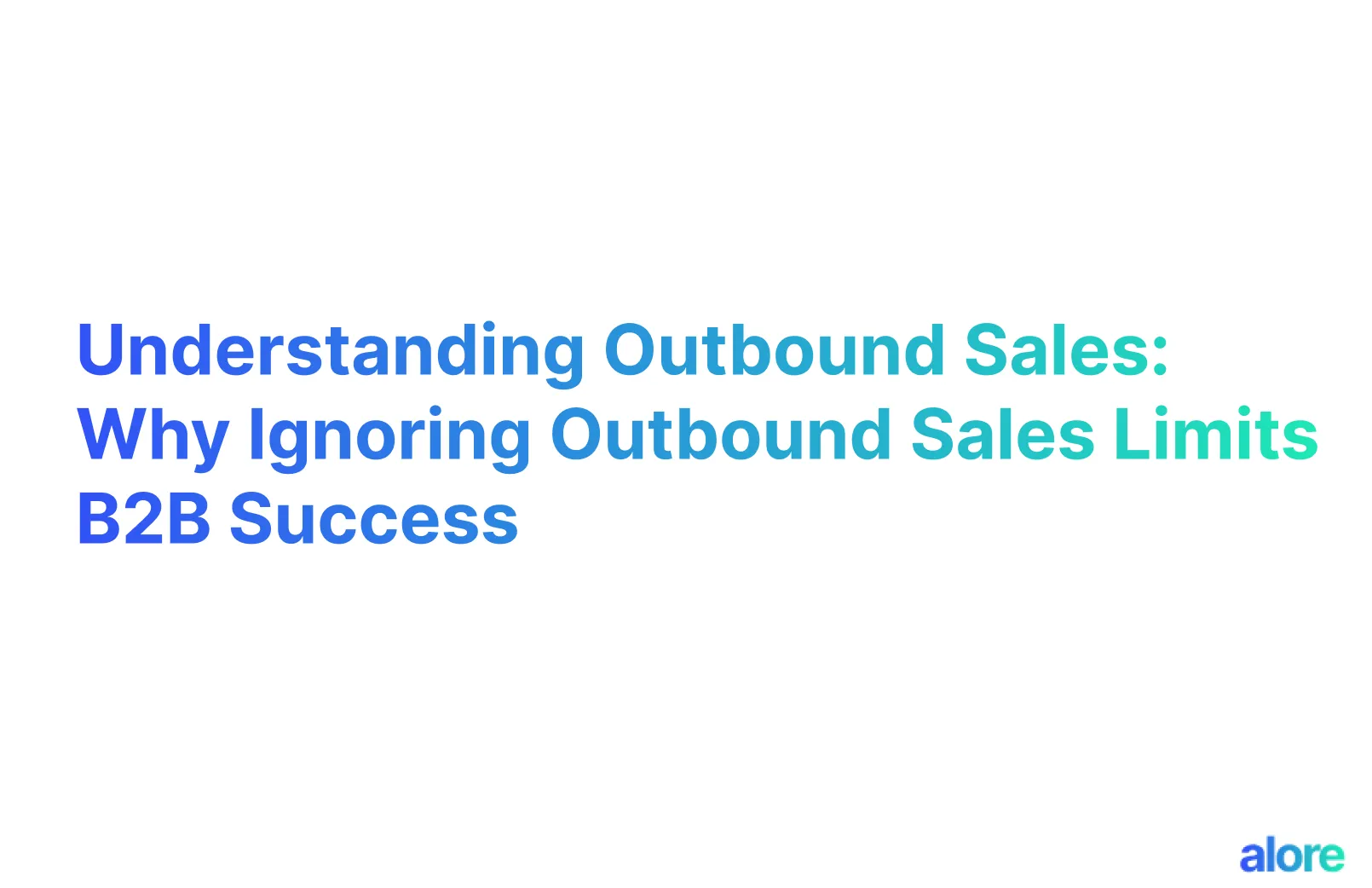Introduction to Outbound Sales
Outbound sales refer to the process where sales representatives initiate contact with potential customers, typically through methods like cold calling, emailing, or social media outreach. The aim is to introduce the prospects to their products or services, identify their needs, and persuade them to make a purchase.
This proactive approach contrasts with inbound sales, where businesses attract customers through advertising and content marketing, waiting for them to make the first move.
This approach is all about reaching out first, using various methods to engage and convert prospects' outbound leads into customers.
What is Outbound Sales?

At its core, outbound sales stand as the strategic cornerstone of proactive customer engagement. This method of customer relationship management is designed around the sales teams reaching out to potential clients through various channels, such as:
Cold Calling: The quintessential outbound sales call technique, evolving from simple call attempts to a more refined approach that includes:
- Targeted prospect identification, using outbound sales software and CRM to streamline the process.
- Personalized scripting based on customer data to ensure relevance and engagement.
- Strategic call timing to increase the likelihood of positive interactions.
Cold Emailing: Far from the spray-and-pray methods of the past, today’s cold emailing is all about:
- Leveraging analytics and sales metrics to tailor messages that resonate.
- Crafting follow-up emails that keep potential customers engaged without being intrusive.
- Utilizing outbound sales tools to automate and optimize email campaigns.
LinkedIn Messaging: A modern twist to outbound sales, where sales reps:
- Engage with potential leads through thoughtful, value-driven posts.
- Use direct messaging to establish a personal connection, often supported by insights from the sales CRM.
- Build long-term relationships that go beyond a single sale, focusing on generating qualified leads and nurturing potential buyers.
The Evolution of Outbound Sales: From Cold Calling to Strategic Outreach

The trajectory of outbound sales has seen a significant transformation, moving outbound sales challenges from a numbers game to a strategic endeavor that emphasizes quality over quantity.
Embracing New Technologies: The integration of advanced sales tools and software has brought about a new era in outbound sales, highlighting the importance of:
- Data-driven decision-making to refine sales strategies.
- CRM systems to manage customer relationships more effectively.
The Rise of Social Selling: Platforms like LinkedIn have become invaluable for:
- Sharing insightful content that attracts potential customers.
- Engaging in meaningful conversations that build trust and credibility.
Multi-Channel Outreach: The success of effective outbound sales strategy now hinges on the ability to:
- Reach target audiences through a variety of channels, ensuring messages are both seen and heard.
- Employ a blend of traditional and digital methods to create a comprehensive outreach strategy.
Transitioning between traditional methods and these modern strategies highlights the dynamic nature of outbound sales. With a focus on customer acquisition cost, sales cycle time, and leveraging the right mix of techniques, businesses can achieve greater efficiency and success in their outbound selling efforts.
The Outbound Sales Process

Understanding the dynamics of the outbound sales process is crucial for businesses aiming to expand their reach and drive sales. This strategy, which involves proactive outreach to potential customers, is a cornerstone of a comprehensive sales strategy.
By initiating contact with prospects through various techniques, companies can effectively pitch their products or services, tailor their messages to meet the specific needs of their target audience, and, ultimately, close more deals.
Why is the Outbound Sales Process Relevant Today?
The outbound sales process allows sales teams to proactively analyze data and reach their target audience, making it possible to tailor the sales pitch directly to the potential customers' needs and pain points. This direct approach ensures the product or service is presented in a way that resonates, increasing the likelihood of engagement.
Outbound Sales Techniques:
Cold Emailing
A strategic approach to cold emailing involves personalizing messages to address potential customers' specific challenges and needs. You can pique interest and initiate valuable conversations by offering solutions through your product or service.
Cold Calling
Despite the prevalence of digital communication, cold calling remains a powerful tool for direct engagement. Training sales reps to conduct effective cold calls can lead to immediate feedback and opportunities for sales.
LinkedIn Messaging
Leveraging professional networks on LinkedIn for outbound prospecting allows for targeted outreach. Engaging potential customers through thoughtful messages can foster connections and drive interest.
Direct Mail
In an increasingly digital world, direct mail stands out for its tangible touchpoint with prospects. Tailoring mail content to reflect the unique selling points of your product or service can capture attention and generate leads.
Difference Between Inbound and Outbound sales

Understanding the nuances between inbound and outbound sales is crucial for businesses aiming to optimize their sales strategy and boost efficiency. This section delves into the core distinctions, offering insights into each approach's unique benefits and challenges.
What is Inbound Sales?
Inbound sales focus on attracting potential customers through content marketing, SEO, and other inbound techniques. This strategy leverages the power of generating leads by creating valuable content and using digital channels to attract inbound leads.
It’s about nurturing and engaging prospects who have shown an interest in your product or service, aiming to convert them into new customers.
Important Differences Between Inbound and Outbound Sales
Inbound and outbound sales differ significantly in approach and execution.
While inbound sales revolve around drawing customers to your business through engaging content and inbound marketing strategies, outbound sales involve proactive outreach to potential customers through cold calling, emails, and outbound sales campaigns.
In an outbound model, the sales team often uses a more direct approach to initiate sales conversations, targeting new and existing customers to close deals.
Inbound Sales Vs. Outbound Sales - Choosing the Right Strategy for Your Business
Selecting the optimal sales strategy for your business—whether inbound sales or outbound sales—requires a nuanced understanding of your goals, resources, and target audience. It's not merely a choice between two distinct methods but an exploration of how each can serve your broader objectives.
How much time can I dedicate to strategy implementation?
Outbound Sales: Requires an upfront investment in time for training sales reps in effective outbound sales tactics like cold calling and making outbound sales calls. The immediacy of outbound efforts demands a focused and intensive approach right from the start.
Inbound Sales: Develops over a longer trajectory, relying on content marketing and inbound marketing techniques to gradually draw in leads. Sales teams should plan to cultivate inbound leads steadily, necessitating patience and ongoing content creation efforts.
Who is my intended audience?
Identifying your target audience is critical, as it determines the approach and messaging of your sales efforts:
Outbound Sales Teams aim for precision, tailoring messages directly to potential customers identified through detailed market analysis. This method is particularly effective for reaching specific customer segments with clear needs and interests.
Inbound Sales cast a wider net, leveraging content marketing to attract a diverse audience. The goal is to create inbound sales focuses that resonate with a broader market, generating leads that can be nurtured over time.
Is now a prudent moment for investment?
Evaluating your current position and market conditions is crucial before launching outbound sales campaigns or doubling down on inbound marketing. Consider both outbound sales metrics and the effectiveness of your current inbound strategies to decide on the best time for investment.
Which customer segment am I aiming to reach?
Segmentation is key in both outbound and inbound strategies. While outbound selling may target specific industries or demographics known to respond well to direct sales tactics, inbound aims to attract a variety of leads through educational and engaging content.
Which approach promises a greater return on investment?
Outbound Sales often yield faster results, making it appealing for businesses looking for quick wins. However, the cost per lead can be higher.
Inbound Sales may take longer to show results but often lead to a higher volume of leads at a lower cost per acquisition over time. Businesses should analyze sales metrics and outbound sales metrics to gauge which approach is more likely to meet their ROI expectations.
How does each method contribute to the trust and image I wish to establish?
Building Trust: Outbound methods, through personalized outreach, can quickly build rapport with potential customers, while inbound methods establish your brand as a thought leader over time.
Establishing Image: The blend of outbound selling tactics and inbound marketing strategies can create a comprehensive image of your company that appeals to both the immediate needs and the long-term interests of your target audience.
Inbound and outbound sales are not mutually exclusive. A balanced approach, integrating both strategies, can leverage the immediate impact of outbound efforts with the long-term benefits of inbound marketing.
Step-by-Step Guide to Develop Your Outbound Sales Strategy

Step 1. Define Your Target Audience
Pinpointing your audience is the cornerstone of outbound sales success.
- Conduct thorough market research: Utilize lead generation tools and customer insights to delineate your ideal consumer's demographic and psychographic traits.
- Segment strategically: Break down your target market into more manageable groups based on distinct characteristics or needs.
- Craft detailed buyer personas: Tailor your outreach strategies effectively by developing comprehensive profiles for each segment.
Step 2. Identify Your Sales Goals
Setting clear, measurable goals directs your outbound process and facilitates success tracking.
- Establish achievable benchmarks: Determine attainable targets by considering your business size and industry standards.
- Ensure alignment with broader objectives: Your sales targets should bolster the company's primary goals, like market expansion or share increase.
- Decompose overarching goals: Divide major objectives into smaller, quantifiable milestones for your sales team.
Step 3. Develop Your Value Proposition
A compelling value proposition sets you apart and attracts potential clients.
- Emphasize the unique benefits: Showcase how your product or service addresses specific problems or enhances situations for your target market.
- Clarity is key: Make sure your value proposition succinctly communicates the unique advantages you bring to the table.
- Iterate based on feedback: Refine your proposition using insights from potential clients to make it resonate more effectively.
Step 4. Choose Your Outbound Sales Channels
Opting for the right mix of channels is crucial for reaching your intended audience.
- Assess each channel's impact: Determine where your audience is most active and their preferred modes of communication.
- Combine diverse channels: Integrate cold calling, email, social selling, and direct mail for a well-rounded outreach approach.
- Adapt based on performance: Regularly evaluate each channel's success and adjust your strategy to optimize reach and engagement.
Step 5. Train Your Sales Team
A proficient sales team is instrumental in achieving outbound sales goals.
- Curate an extensive training regimen: Incorporate product knowledge, sales techniques, and customer interaction skills.
- Practice makes perfect: Engage in role-play exercises to replicate outbound sales scenarios, providing constructive feedback to improve.
- Promote ongoing education: Keep your team abreast of the latest industry trends, sales methodologies, and product updates.
Step 6. Implement and Monitor Your Strategy
Actioning your strategy and tracking its effectiveness is pivotal.
- Initiate with a pilot campaign: Trial your strategy on a small scale to collect insights and fine-tune your approach.
- Employ CRM tools effectively: Utilize CRM software to manage leads, record sales calls, and analyze customer interactions.
- Review key metrics regularly: Evaluate essential outbound sales metrics such as lead response rates, sales call success, and overall ROI to refine your strategy continuously.
Formulating an outbound sales strategy is an ongoing journey that demands a deep understanding of your market, the establishment of clear objectives, and adaptability to feedback and results.
Effective Outbound Sales Techniques
Outbound sales techniques are essential for reaching potential customers directly and effectively. Let's dive into some of the most effective methods: cold calling, cold emailing, and leveraging LinkedIn messages.
How to Cold Call Effectively: A Step-by-Step Guide
Mastering Cold Emailing: Comprehensive Guide on How to Get Started
How to use LinkedIn Messages to Generate Leads: The A, B, C's of It
A Day in the Life of Outbound Sales Reps: Key Outbound Sales Activities for Success

Below, we've outlined a typical day, structured by activities and time, to highlight the essentials for outbound sales success.
8:00 AM - Morning Preparation
- Review Goals and Priorities: Begin by reviewing your sales targets and prioritizing tasks for the day.
- Check Emails and Messages: Quickly scan through your inbox for any urgent communications that might require immediate attention.
8:30 AM - Lead Generation and Research
- Prospecting: Use this time to search for new leads. Tools like LinkedIn Sales Navigator can be especially useful for finding potential buyers within your target audience.
- Lead Qualification: Evaluate leads based on predefined criteria to ensure they align with your product or service offerings.
9:30 AM - Cold Calling Block
- Preparation: Spend a few minutes reviewing the key points and value propositions for the calls.
- Making Calls: Dedicate this time solely to cold calling, reaching out to new leads, and making outbound sales calls. Remember, persistence is key; not every call will be a success, but each is a step closer to your goal.
11:00 AM - Break and Email Follow-ups
- Short Break: Take a moment to step away, refresh, and recharge.
- Email Outreach: Follow up on earlier calls with personalized emails, providing additional information about your offerings and setting the stage for further discussions.
12:00 PM - Lunch and Learn
- Networking Lunch: If possible, schedule lunch meetings with potential clients or colleagues to discuss outbound strategies and learn from their experiences.
- Educational Content: Utilize this time for personal development by listening to sales podcasts or reading articles on outbound sales tips and new strategies.
1:30 PM - Social Selling and Content Marketing
- LinkedIn Messaging and Posts: Engage with leads and share valuable content through social selling techniques. This builds trust and keeps you on your leads' radar.
- Content Creation: Work on outbound sales campaigns or collaborate with your marketing team to create compelling content that addresses the needs and challenges of your potential customers.
3:00 PM - Sales Calls and Client Meetings
- Scheduled Calls: Conduct pre-arranged sales calls or virtual meetings with interested leads to discuss how your solution can solve their problems.
- Client Follow-ups: Check in on existing customers or prospects who have shown interest but haven't yet made a decision.
4:30 PM - Administrative Tasks and Planning
- CRM Updates: Update your customer relationship management system with notes from today's calls and meetings to keep track of progress and next steps.
- Plan for Tomorrow: Outline your goals and priorities for the next day, ensuring a head start on your tasks.
5:00 PM - Reflection and Wind Down
- Reflect on the Day: Take a moment to reflect on what went well and what could be improved. Celebrating small wins motivates you for future challenges.
- Prepare for Relaxation: Transition from work mode by setting your workspace in order for the next day, ensuring a clear mind and environment.
Building a Robust Outbound Sales Team

Structuring Your Sales Team for Optimal Outbound Success
The structure of your sales team can significantly impact its efficiency in outbound sales. An optimal arrangement facilitates clear roles, responsibilities, and streamlined processes.
Define Clear Roles: Assign specific roles like sales rep, sales development reps (SDRs), and lead response reps (LRRs) to streamline the outbound process. This clarity ensures each team member knows their focus, whether it's lead generation, making sales calls, or nurturing inbound leads towards outbound sales success.
Segment Teams by Specialty: Differentiate your team based on outbound and inbound sales strategies. This allows for specialization in techniques like cold calls, social selling, or content marketing, enhancing the effectiveness of each approach.
Leverage CRM Tools: Implement customer relationship management (CRM) systems to organize and monitor sales activities. This helps in tracking sales targets, average deal size, and the effectiveness of marketing campaigns.
Training Sales Reps for Outbound Excellence: Tools and Techniques
Training your sales team is pivotal for achieving outbound sales success. Equip your team with the knowledge, tools, and techniques needed to excel in outbound sales.
Product Knowledge Training: Ensure every sales rep understands the product or service in-depth. This knowledge is crucial for explaining the value during sales calls and persuading new customers.
Teach Outbound Sales Techniques: Focus on methods such as making effective cold calls, crafting compelling outbound sales tips, and utilizing social selling to engage potential customers. Incorporating outbound sales meaning and referring to success stories can motivate reps.
Implement Sales Call Simulations: Practice sales calls with role-playing exercises to build confidence and refine sales pitches. This helps in handling real-world scenarios, from initial contact to closing deals.
Use Real-Life Case Studies: Analyze data from successful campaigns to highlight what works. Discussing outbound strategies that led to significant lead generation or increased sales targets can provide practical insights.
Encourage Continuous Learning: Promote ongoing education on outbound sales refers, new market trends, and emerging outbound process techniques. Sales professionals should be adept at adapting to changing environments and leveraging tools like social selling and phone calls effectively.
Tools for Outbound Sales: 5 Key Advantages of Using Alore for Outbound Sales
1. Enhanced Email Deliverability
Alore's email warmer ensures your messages consistently hit the inbox, boosting open rates and engagement by maintaining a solid sender reputation.
2. Automated Drip Campaigns
Automate lead nurturing with targeted drip campaigns, saving time while effectively moving prospects through the sales funnel with personalized follow-ups.
3. Collaborative Inbox for Team Efficiency
Streamline email management with a shared inbox, allowing your team to coordinate responses and follow-ups, ensuring no lead is overlooked.
4. Data-Driven Insights
Leverage Alore's integration with CRM and sales tools for comprehensive analytics on campaign performance, enabling informed strategy adjustments for higher conversion rates.
5. Expert Support and Coaching
Benefit from personalized guidance and coaching through Alore's support programs, equipping your team with strategies and insights to maximize outbound sales success.
Alore combines critical sales tools and support to optimize your outbound efforts, ensuring better reach, engagement, and conversion.
Request a Demo: Explore Alore’s features and capabilities through a personalized demo
Common Challenges Outbound Sales
The C.A.L.M. Framework for Overcoming Objections in Outbound Sales Calls
To navigate these objections effectively, We at Alore use a unique, easy-to-remember framework: C.A.L.M. This acronym stands for Clarify, Acknowledge, Leverage, and Move Forward.
It's designed to help sales reps systematically address and overcome objections during sales calls, turning potential setbacks into opportunities for engagement and conversion.
Applying the C.A.L.M. Framework:
Imagine you're on a sales call, and the prospect objects to the price being too high. Here's how the C.A.L.M. framework can come into play:
- Clarify: "Could you share more about your budget constraints or what you're comparing our pricing against?"
- Acknowledge: "I understand that budget is a crucial consideration for your team."
- Leverage: "Many of our clients have found that the ROI, considering our comprehensive support and features, justifies the investment. I can show you some case studies if that would help."
- Move Forward: "What if we explored some customizable options that might fit better within your budget? Can we set up a time to discuss this in more detail?"
Strategies for Maintaining Momentum in Your Outbound Sales Efforts
Keeping the momentum in outbound sales requires consistent effort and strategic planning. Here's how to sustain energy and focus over the long haul.
Set Clear Goals: Establish clear, measurable sales targets to provide direction and motivation for your sales teams. Regularly review these goals to ensure they remain challenging yet achievable.
Leverage Technology: Utilize outbound sales tools and CRM systems to streamline processes, manage customer data efficiently, and automate repetitive tasks, allowing more time for high-value activities like making sales calls and closing deals.
Foster Team Collaboration: Encourage collaboration between sales development reps, outbound reps, and other members of the sales team. Sharing outbound sales refers, tips, and tactics can inspire new ideas and approaches.
Continuous Training: Provide ongoing training on new outbound sales techniques, phone calls strategies, and social selling tips to keep the team updated and skilled in overcoming objections and handling rejections.
Handling Rejections
Rejection is an inevitable aspect of the outbound sales process. Developing a resilient mindset and effective strategies is essential for moving past rejections and finding success.
Don't Take It Personally: Understand that rejections are not a reflection of your worth as a sales professional. They are often due to factors beyond your control, such as timing or budget constraints.
Learn From Each Rejection: Analyze each rejection to identify patterns or areas for improvement. This could involve refining your sales call approach, adjusting your lead generation strategy, or enhancing your product or service presentation.
Stay Positive and Persistent: Maintain a positive attitude and keep pushing forward. Use rejections as motivation to refine your outbound sales tactics and improve your approach.
Seek Support: Don't hesitate to seek advice or support from more experienced sales development reps or managers. Learning from others' experiences can provide valuable insights into overcoming common objections and handling rejections more effectively.
Further Reading: Enhance Your Outbound Sales Skills
For those looking to deepen their understanding of outbound sales techniques, particularly in crafting compelling cold emails and mastering cold calls, the following resources offer valuable insights and actionable advice:
- Improving Cold Email Conversion Rates: Discover strategies to increase the effectiveness of your cold emails, turning prospects into engaged leads. Read more.
- Cold Email Templates for B2B Sales: Access proven templates designed to capture the attention of B2B prospects and initiate meaningful business relationships. Explore templates.
- Prospecting Mastery: Learn the art of identifying and connecting with potential customers to build a robust pipeline for your sales efforts. Dive into prospecting.
- Cold Emailing vs. Cold Calling: Understand the benefits of cold emailing compared to traditional cold calling, and why it might be the better choice for your outreach strategy. Compare the approaches.
- Cold Callers’ Guide: Gain insights into effective cold calling techniques that can help you break through to your target audience with confidence. Learn cold calling.
- The Art of Cold Calling: Further explore cold calling strategies to enhance your ability to connect with prospects over the phone and convert them into leads. Master cold calling.





.webp)


